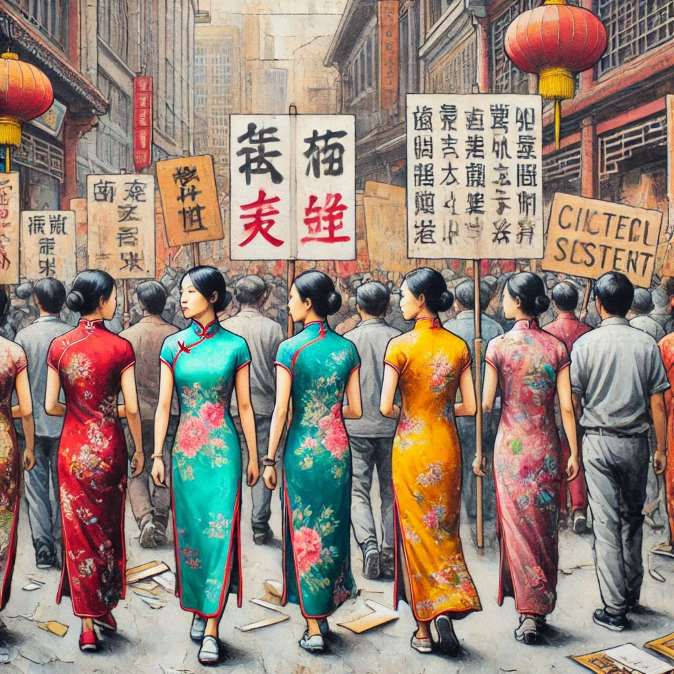Chinese dresses, particularly the cheongsam or qipao, are more than traditional garments. They have evolved into potent symbols of resistance, identity, and cultural pride, often playing a pivotal role in political protests and movements. Their rich history and striking designs have enabled them to convey powerful messages, blending elegance with activism.
The significance of these dresses has grown immensely, influencing various platforms of cultural expression and dissent. Websites like RobesChinoises showcase the enduring allure of traditional Chinese dress, highlighting its potential as both fashion and a medium for storytelling. As political movements worldwide explore creative methods of protest, the Chinese dress has emerged as a unique form of non-verbal communication (source: robe traditionnelle chinoise by RobesChinoises).
Cultural Roots and Political Symbolism

The qipao, originally a Qing Dynasty creation, represents a fusion of history and modernity. It has always been a visual representation of Chinese heritage. In political contexts, wearing traditional attire becomes an act of reclaiming identity and standing against forces that seek to erase cultural uniqueness.
For example, during movements in Hong Kong advocating for democratic freedoms, the cheongsam became a subtle but recognizable symbol. Protesters used the dress to emphasize their connection to a rich cultural heritage, contrasting this against perceived threats of cultural homogenization. Its use signalled defiance while invoking pride in local traditions.
Feminism and the Chinese Dress
The Chinese dress also plays a critical role in conversations about gender and feminism. Historically seen as a marker of grace and femininity, it has been reclaimed as a statement of empowerment. Women wearing cheongsams during demonstrations challenge traditional gender norms, asserting their presence in male-dominated spaces.
This garment often serves as a double-edged symbol in protests: a nod to cultural pride and asserting women’s strength. Activists have worn it during events advocating for gender equality, showing that tradition and progress can coexist.
Global Protests and Cultural Preservation
The adoption of Chinese dresses in protests isn’t limited to China. Across the globe, diasporic communities have used traditional attire as a means of preserving their roots while demanding rights or justice. This global resonance highlights the versatility of the qipao as a political tool.
In the United States and Europe, activists have worn these dresses during rallies to call attention to issues like anti-Asian hate crimes. The choice to wear traditional attire sends a clear message: their heritage should not be erased or dismissed but celebrated and protected.
Art, Fashion, and Protest
Art and fashion have always been intertwined with resistance, and the Chinese dress is no exception. Modern designers often reinterpret traditional styles to reflect contemporary struggles, using bold prints, slogans, or modifications that resonate with current events. These creations further the narrative of the qipao as an evolving symbol of resilience.
In recent protests, dresses have been adorned with protest messages or paired with accessories that amplify their symbolism. This creative approach adds layers of meaning, making the qipao a cultural artifact and an art form in activism.
Why the Chinese Dress Resonates
The enduring appeal of the Chinese dress in protests lies in its ability to communicate complex messages with simplicity. It embodies tradition, elegance, and defiance, making it an ideal tool for non-violent resistance. Protesters leveraging this garment create a visual impact that is hard to ignore, blending history with contemporary struggles.
Moreover, the global fascination with Chinese culture amplifies the qipao’s influence. Its use in protests ensures that the message reaches audiences far beyond the immediate context, fostering a deeper understanding of the issues at hand.
READ ALSO: Politicians Love Their Workboots…And Sneakers?
A Powerful Symbol of Resistance
The Chinese dress is far more than a garment; it is a canvas for resistance, an assertion of identity, and a bridge between the past and the present. Its role in political protests underscores the power of cultural symbols in driving change. By wearing the qipao, protesters remind the world of the strength found in heritage, proving that traditions can be powerful agents of progress.
As movements evolve, so will the ways people use symbols like the Chinese dress to express their voices. Its versatility and profound cultural significance make it a timeless tool in the fight for justice and equality.
